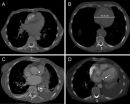(Press-News.org) Researchers from the University of Jyväskylä report a new method of building molecular cages. The method involves the exploitation of intermolecular steric effects to control the outcome of a self-assembly reaction.
Molecular cages are composed of organic molecules (ligands) which are bound to metal ions during a self-assembly process. Depending on the prevailing conditions, self-assembly processes urge to maximize the symmetry of the system and thus occupy every required metal binding site. The research group led by docent Manu Lahtinen (University of Jyväskylä, Department of Chemistry) developed a method in which sterically hindered ligands are used to seemingly disrupt the self-assembly process. This new strategy allows a ligand to occupy only two of the four potential binding sites of the metal. The created molecular cage presents a low symmetric tetrahedral intermediate product in a reaction that would generally yield a higher symmetric octahedral cage.
The reported results provide new insights on how self-assembly processes of metal-organic systems can be controlled. However, the most significant feature of the proposed method is the new way of building molecular cages with vacant metal binding sites. This creates an opportunity to modify the properties and behavior of pre-assembled cages by incorporating functionally significant molecules to partially exposed metal ions. The presented strategy provides a new concept to build more complex molecular cages.
Molecular cages are the materials of tomorrow
Molecular cages and capsules are hollow nano-sized (1 x 10-9 m) compounds that consist of organic molecules or ions and, in most cases, metal ions. They share many structural features with, for example, viruses whose shells (capsids) are composed of organized proteins. One of the most significant feature of molecular cages is their ability to bind and release guest molecules depending on the prevailing conditions. Hence, some of their most important potential applications include biomedicinal uses (transport of drugs), storing of unstable and/or reactive molecules and recovery of hazardous compounds from aquatic environment.
INFORMATION:
The present study was published in the journal Chemical Communications and is part of M.Sc. Anssi Peuronen's doctoral thesis that focuses on the study of structural chemistry of cationic ammonium compounds and is supervised by Docent Manu Lahtinen. The third member of the research group is M.Sc. student Samu Forsblom.
Anssi Peuronen, Samu Forsblom and Manu Lahtinen: Sterically controlled self-assembly of tetrahedral M6L4 cages via cationic N-donor ligands, Chem. Commun., 2014, 50, 5469 - 5472, http://dx.doi.org/10.1039/C3CC49663E
More information:
Senior Lecturer, Docent Manu Lahtinen, tel. +358 408 053 696, manu.k.lahtinen@jyu.fi Doctoral student, M.Sc. Anssi Peuronen, tel. +358 408 053 715, anssi.peuronen@jyu.fi
This research was funded by the Inorganic Materials Chemistry Graduate Program (EMTKO) along with the University of Jyväskylä.
New perspectives to the design of molecular cages
2014-05-27
ELSE PRESS RELEASES FROM THIS DATE:
Molecules do the triple twist
2014-05-27
An international research team led by Academy Professor Kari Rissanen of the University of Jyväskylä (Finland) and Professor Rainer Herges of the University of Kiel (Germany) has managed to make a triple-Möbius annulene, the most twisted fully conjugated molecule to date, as reported in Nature Chemistry (DOI:10.1038/nchem.1955, published online 25 May 2014).
An everyday analogue of a single twisted Möbius molecule is a Möbius strip. It can be made easily by twisting one end of a paper strip by 180 degrees and then joining the two ends. A triple twisted Möbius molecule ...
Insights into genetics of cleft lip
2014-05-27
Scientists at the European Molecular Biology Laboratory (EMBL) in Heidelberg, have identified how a specific stretch of DNA controls far-off genes to influence the formation of the face. The study, published today in Nature Genetics, helps understand the genetic causes of cleft lip and cleft palate, which are among the most common congenital malformations in humans.
"This genomic region ultimately controls genes which determine how to build a face and genes which produce the basic materials needed to execute this plan", says François Spitz from EMBL, who led the work. ...
Clinical trial reaffirms diet beverages play positive role in weight loss
2014-05-27
May 27, 2014 – A groundbreaking new study published today in Obesity, the journal of The Obesity Society, confirms definitively that drinking diet beverages helps people lose weight.
"This study clearly demonstrates that diet beverages can in fact help people lose weight, directly countering myths in recent years that suggest the opposite effect – weight gain," said James O. Hill, Ph.D., executive director of the University of Colorado Anschutz Health and Wellness Center and a co-author of the study. "In fact, those who drank diet beverages lost more weight and reported ...
Heavily decorated classrooms disrupt attention and learning in young children
2014-05-27
VIDEO:
Maps, number lines, shapes, artwork and other materials tend to cover elementary classroom walls. However, new research from Carnegie Mellon University shows that too much of a good thing may...
Click here for more information.
PITTSBURGH—Maps, number lines, shapes, artwork and other materials tend to cover elementary classroom walls. However, new research from Carnegie Mellon University shows that too much of a good thing may end up disrupting attention and learning in ...
Migrating stem cells possible new focus for stroke treatment
2014-05-27
Two years ago, a new type of stem cell was discovered in the brain that has the capacity to form new cells. The same research group at Lund University in Sweden has now revealed that these stem cells, which are located in the outer blood vessel wall, appear to be involved in the brain reaction following a stroke.
The findings show that the cells, known as pericytes, drop out from the blood vessel, proliferate and migrate to the damaged brain area where they are converted into microglia cells, the brain's inflammatory cells.
Pericytes are known to contribute to tissue ...
Health issues, relationship changes trigger economic spirals for low-income rural families
2014-05-27
When it comes to the factors that can send low-income rural families into a downward spiral, health issues and relationship changes appear to be major trigger events. Fortunately, support networks – in particular, extended families – can help ease these poverty spells, according to new research from the NH Agricultural Experiment Station at the University of New Hampshire College of Life Sciences and Agriculture.
The research was conducted by Elizabeth Dolan, emeritus associate professor of family studies at UNH, and her colleagues Sheila Mammen at the University of ...
Africa's longest-known terrestrial wildlife migration discovered
2014-05-27
WASHINGTON, DC - Researchers have documented the longest-known terrestrial migration of wildlife in Africa – up to several thousand zebra covering a distance of 500km (more than 300 miles) – according to World Wildlife Fund (WWF).
Using GPS collars on eight adult Plains zebra (Equus quagga), WWF and Namibia's Ministry of Environment and Tourism (MET), in collaboration with Elephants Without Borders (EWB) and Botswana's Department of Wildlife and National Parks, tracked two consecutive years of movement back and forth between the Chobe River in Namibia and Botswana's Nxai ...
Chest CT helps predict cardiovascular disease risk
2014-05-27
OAK BROOK, Ill. – Incidental chest computed tomography (CT) findings can help identify individuals at risk for future heart attacks and other cardiovascular events, according to a new study published online in the journal Radiology.
"In addition to diagnostic purposes, chest CT can be used for the prediction of cardiovascular disease," said Pushpa M. Jairam, M.D., Ph.D., from the University Medical Center Utrecht, in Utrecht, the Netherlands. "With this study, we have taken a new perspective by providing a different approach for cardiovascular disease risk prediction ...
An area's level of poverty or wealth may affect the distribution of cancer types
2014-05-27
A new analysis has found that certain cancers are more concentrated in areas with high poverty, while other cancers arise more often in wealthy regions. Also, areas with higher poverty had lower cancer incidence and higher mortality than areas with lower poverty. Published early online in CANCER, a peer-reviewed journal of the American Cancer Society, the study's findings demonstrate the importance of including measures of socioeconomic status in national cancer surveillance efforts.
Overall, socioeconomic status is not related to cancer risk—cancer strikes the rich and ...
E-cigarettes: Not a healthy alternative to smoking
2014-05-27
ARLINGTON HEIGHTS, Ill. (May 27, 2014) – Caveat emptor – or "buyer beware" holds true when it comes to the unknown health effects of e-cigarettes. An article in the June issue of Annals of Allergy, Asthma & Immunology, the scientific journal of the American College of Allergy, Asthma and Immunology (ACAAI), examines risks, including the ongoing dependence on nicotine and the dual use of e-cigarettes and regular cigarettes.
The article examines the idea that one of the initial "health benefits" proposed by e-cigarettes makers was that it would help those who smoke cigarettes ...


